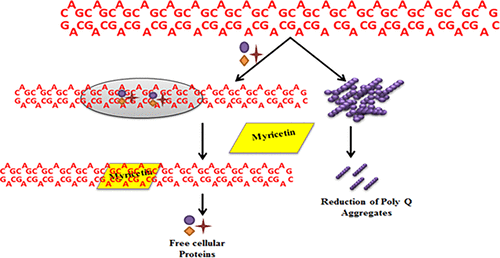当前位置:
X-MOL 学术
›
ACS Chem. Biol.
›
论文详情
Our official English website, www.x-mol.net, welcomes your
feedback! (Note: you will need to create a separate account there.)
Myricetin Reduces Toxic Level of CAG Repeats RNA in Huntington’s Disease (HD) and Spino Cerebellar Ataxia (SCAs)
ACS Chemical Biology ( IF 3.5 ) Pub Date : 2017-12-18 00:00:00 , DOI: 10.1021/acschembio.7b00699 Eshan Khan 1 , Arpita Tawani 1 , Subodh Kumar Mishra 1 , Arun Kumar Verma 1 , Arun Upadhyay 2 , Mohit Kumar 3 , Rajat Sandhir 3 , Amit Mishra 2 , Amit Kumar 1
ACS Chemical Biology ( IF 3.5 ) Pub Date : 2017-12-18 00:00:00 , DOI: 10.1021/acschembio.7b00699 Eshan Khan 1 , Arpita Tawani 1 , Subodh Kumar Mishra 1 , Arun Kumar Verma 1 , Arun Upadhyay 2 , Mohit Kumar 3 , Rajat Sandhir 3 , Amit Mishra 2 , Amit Kumar 1
Affiliation

|
Huntington’s disease (HD) is a neurodegenerative disorder that is caused by abnormal expansion of CAG repeats in the HTT gene. The transcribed mutant RNA contains expanded CAG repeats that translate into a mutant huntingtin protein. This expanded CAG repeat also causes mis-splicing of pre-mRNA due to sequestration of muscle blind like-1 splicing factor (MBNL1), and thus both of these elicit the pathogenesis of HD. Targeting the onset as well as progression of HD by small molecules could be a potent therapeutic approach. We have screened a set of small molecules to target this transcript and found Myricetin, a flavonoid, as a lead molecule that interacts with the CAG motif and thus prevents the translation of mutant huntingtin protein as well as sequestration of MBNL1. Here, we report the first solution structure of the complex formed between Myricetin and RNA containing the 5′CAG/3′GAC motif. Myricetin interacts with this RNA via base stacking at the AA mismatch. Moreover, Myricetin was also found reducing the proteo-toxicity generated due to the aggregation of polyglutamine, and further, its supplementation also improves neurobehavioral deficits in the HD mouse model. Our study provides the structural and mechanistic basis of Myricetin as an effective therapeutic candidate for HD and other polyQ related disorders.
中文翻译:

杨梅素降低亨廷顿氏病(HD)和脊髓小脑共济失调(SCAs)中CAG重复RNA的毒性水平
亨廷顿舞蹈病(HD)是一种神经退行性疾病,由HTT基因中C A G重复序列的异常扩增引起。转录的突变RNA包含扩展的C A G重复序列,可翻译为突变的亨廷顿蛋白。由于肌肉盲状样1剪接因子(MBNL1)的隔离,这种扩展的CAG重复还导致前mRNA的错误剪接,因此这两者都引发了HD的发病机理。通过小分子靶向HD的发作和发展可能是一种有效的治疗方法。我们筛选了一组靶向该转录本的小分子,发现黄酮类的杨梅素是与C A相互作用的先导分子G基序,从而阻止了突变型亨廷顿蛋白的翻译以及MBNL1的隔离。这里,我们报告杨梅酮和RNA含有5'C之间形成的复合物的第一溶液结构甲G / 3'G甲C图案。杨梅素通过AA错配处的碱基堆积与该RNA相互作用。此外,还发现了杨梅素减少了由于聚谷氨酰胺聚集而产生的蛋白毒性,此外,其补充还改善了HD小鼠模型中的神经行为缺陷。我们的研究提供了杨梅素作为HD和其他polyQ相关疾病的有效治疗候选者的结构和机理基础。
更新日期:2017-12-18
中文翻译:

杨梅素降低亨廷顿氏病(HD)和脊髓小脑共济失调(SCAs)中CAG重复RNA的毒性水平
亨廷顿舞蹈病(HD)是一种神经退行性疾病,由HTT基因中C A G重复序列的异常扩增引起。转录的突变RNA包含扩展的C A G重复序列,可翻译为突变的亨廷顿蛋白。由于肌肉盲状样1剪接因子(MBNL1)的隔离,这种扩展的CAG重复还导致前mRNA的错误剪接,因此这两者都引发了HD的发病机理。通过小分子靶向HD的发作和发展可能是一种有效的治疗方法。我们筛选了一组靶向该转录本的小分子,发现黄酮类的杨梅素是与C A相互作用的先导分子G基序,从而阻止了突变型亨廷顿蛋白的翻译以及MBNL1的隔离。这里,我们报告杨梅酮和RNA含有5'C之间形成的复合物的第一溶液结构甲G / 3'G甲C图案。杨梅素通过AA错配处的碱基堆积与该RNA相互作用。此外,还发现了杨梅素减少了由于聚谷氨酰胺聚集而产生的蛋白毒性,此外,其补充还改善了HD小鼠模型中的神经行为缺陷。我们的研究提供了杨梅素作为HD和其他polyQ相关疾病的有效治疗候选者的结构和机理基础。











































 京公网安备 11010802027423号
京公网安备 11010802027423号